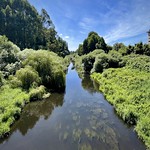The ugliest town in Chile
When we crossed into Chile from Argentina, we were asked for our vaccination cards. The only time on our trip this happened. We didn’t ask what would have occurred if we had had no proof of vaccination on us.
Osorno, the town we were heading to, is not the most interesting architectural gem, even if their central cathedral is impressive. It’s brutalist, and almost has a filigree feel to it.
At the same time, some, at least our host in Santiago, consider Osorno the ugliest town in Chile. Though this felt to me like a bit of a stretch.
What is surprising that, although the city was founded as far back as 1558, there is very little of historical Osorno left. You can visit the tiny remnants of an old fort, in a nearly forgotten corner of the city, but the fort is cut in half, and could easily have been a modern afterthought.
Yet there is some real history in the area.
After fighting over control of the land, which included clashes between the Spanish and the Dutch, as well as the Spanish and the indigenous Huilliche, the area became an independent indigenous territory, inaccessible to the Spanish, which lead to speculation that the area contained the mythical ‘city of the caesars, a local Eldorado.
The origin of that myth is likely to have been an amalgamation of a collection of tall tales connected to the colonisation of the area, with one important trigger perhaps being the indigenous telling sailors about the Incan empire to the north.
After the area opened up again in the late 18th century, the Spanish moved in fast, purchasing the land from the indigenous population. An important economic driver, even today, livestock grazing, was founded predominantly by Basque immigrants.
Then, in the second half of the 19th century, the government encouraged German immigration, of which the presence is still strong, and which drove the beer industry in Chile’s south.
Perhaps the most interesting feature of the city was the large number of birds of prey, hawks perhaps, who were occupying the downtown area, behaving more like pigeons than predators.
We had to rush on; we had wanted to celebrate the new year in Santiago, which was still a night bus away.



















